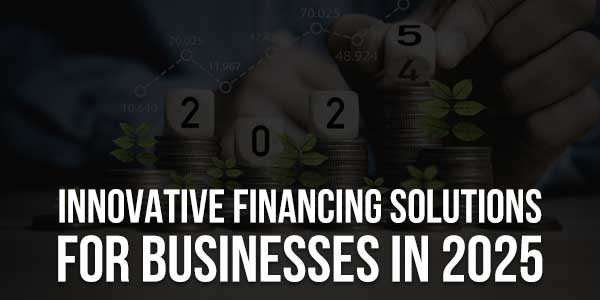
In today’s rapidly evolving economy, smart business financing isn’t just an option—it’s a necessity. As we head into 2025, small and mid-sized businesses must adopt forward-thinking financial strategies that ensure stability, scalability, and a competitive edge. Whether you’re launching a startup or expanding your operations, choosing the right mix of financing tools can make or break your growth trajectory.
This article explores smart business financing strategies tailored for 2025, with a special focus on financial investment planning and business loans.
Table of Contents
Why Smart Financing Matters in 2025?
2025 brings with it economic uncertainties, digital transformation, and increased competition across sectors. In such a landscape, businesses that manage their finances strategically will see significant benefits.
Smart financing ensures:
- Improved cash flow efficiency: Maintaining liquidity for daily operations without disruption.
- Reduced borrowing costs: Identifying optimal lending options to lower interest payments.
- Operational flexibility: Being ready to scale, pivot, or innovate when needed.
- Investor confidence: Clear financial planning attracts equity partners and venture capital.
- Sustainable growth: Smart financing supports expansion while preserving long-term stability.
By staying financially agile and aware, businesses are better prepared for risks and well-positioned for growth.
1.) Reassess Your Capital Structure:
Smart financing starts with evaluating your existing capital structure. This means finding the right balance between equity (ownership-based capital) and debt (borrowed capital).
In 2025, financial experts advise:
- Maintaining an optimal debt-to-equity ratio to avoid over-leveraging.
- Using short-term loans for operational costs and liquidity.
- Using long-term loans or equity for expansion and capital investments.
A well-structured capital base reduces the cost of capital and strengthens the company’s financial foundation. Regularly reviewing your capital mix ensures that you’re not over-dependent on a single funding source.
2.) Use Business Loans Strategically:
Business loans remain one of the most practical and accessible forms of financing. However, to be effective, they must be used strategically:
Term Loans for Expansion:
Use long-term loans to finance significant investments like buying equipment, property, or expanding to new markets. These loans offer predictable EMIs and often come with lower interest rates.
Working Capital Loans for Day-to-Day Operations:
Working capital loans help cover temporary shortfalls due to seasonal fluctuations or unexpected expenses.
Line of Credit for Flexibility:
Lines of credit offer flexible borrowing limits, ideal for managing short-term cash needs without high-interest burdens.
Invoice Financing:
If you’re waiting on receivables, invoice financing can help improve liquidity without taking on new debt.
Pro tip: Always use a business loan calculator to estimate EMIs and total payable interest before applying.
3.) Invest in Financial Planning Tools:
Digital tools have transformed financial decision-making. In 2025, using smart planning tools isn’t just a bonus—it’s essential.
Modern tools include:
- AI-driven forecasting software that helps project revenues and future needs.
- Loan comparison and EMI calculators to evaluate borrowing costs quickly.
- Cash flow management platforms to monitor incoming and outgoing funds in real time.
These tools reduce manual work and enhance accuracy, allowing entrepreneurs to make proactive financial decisions.
4.) Leverage Government Schemes and Grants:
Governments across the globe offer financial aid to boost entrepreneurship and small business growth. In 2025, tapping into these opportunities can lower borrowing costs.
Explore programs like:
- MUDRA Loans (India): For micro and small businesses.
- SBA Loans (USA): Backed by the Small Business Administration, offering lower rates.
- EU Startup Grants (Europe): Focused on innovation and sustainability.
These schemes often feature low interest rates, long repayment terms, and minimal collateral requirements.
5.) Attract Investors with a Clear ROI Plan:
In 2025, competition for venture capital and angel funding is high. Investors seek clarity, structure, and return on investment (ROI).
To stand out:
- Present a transparent fund utilisation plan.
- Showcase milestones, revenue projections, and break-even analysis.
- Provide regular financial updates and measurable impact metrics.
Building trust and showing accountability can help secure funding and long-term partnerships.

6.) Explore Asset-Based Lending:
Asset-based lending (ABL) is a powerful option for businesses with valuable physical or financial assets. ABL provides capital based on the value of:
- Inventory
- Accounts receivable
- Machinery or equipment
- Commercial property
Compared to unsecured loans, ABL usually offers higher loan amounts and lower interest rates. It’s ideal for businesses in growth mode but with cash flow constraints.
7.) Opt for Hybrid Financing Models:
One-size-fits-all financing is outdated. In 2025, combining multiple funding types ensures flexibility and reduces dependency on any single source.
Common hybrid models include:
- A term loan for long-term assets or infrastructure.
- A line of credit for short-term needs.
- Equity investment for innovation and marketing.
This approach balances risk, cost, and liquidity.
8.) Maintain a Strong Credit Profile:
Creditworthiness remains central to borrowing. Lenders and investors use credit profiles to assess risk.
Improve your profile by:
- Making on-time EMI and bill payments
- Keeping credit utilisation below 30%
- Monitoring reports and fixing errors quickly
A strong credit history leads to better loan terms and faster approvals.
9.) Monitor Market Trends and Interest Rates:
Being proactive about external economic changes helps businesses make timely financing decisions.
In 2025:
- Monitor central bank policies and lending trends
- Choose floating rates if interest is expected to drop
- Lock in fixed rates when interest rates are low
10.) Review and Adjust Financing Regularly:
Business needs to evolve rapidly. A tactic that was successful last year might not be effective now.
Every 6–12 months:
- Revisit your funding sources
- Consider refinancing for better terms
- Update your financing plan to match new goals
This habit ensures continued financial health and responsiveness to market opportunities.
Business Success in 2025: The Strategic Shift:
In 2025, business success requires a fundamental shift in mindset—from reactive borrowing to proactive and strategic financing. Rather than seeking funding only in times of need, forward-thinking businesses are planning their financing approaches well in advance, aligning them with their long-term vision and goals.
This shift involves several key elements:
- Choosing the Right Loan Types: Businesses must evaluate and match loan products to their specific needs. For instance, term loans for expansion, working capital loans for operations, or asset-based loans for leveraging equipment or receivables.
- Leveraging Technology and AI Tools: AI-powered financial software can help forecast cash flows, optimise budgets, and assess financing risks. These tools bring data-driven insights, reducing guesswork and improving strategic planning.
- Utilising Government Support Programs: Governments worldwide are offering grants, subsidies, and low-interest financing to support innovation, sustainability, and small business growth. Businesses should proactively monitor and apply for relevant schemes.
- Building Adaptable Strategies: In today’s volatile markets, flexibility is crucial. Businesses should be prepared to pivot their financing strategies based on changes in market conditions, interest rates, and operational needs.
Strategic financial management not only drives growth but also creates a cushion against unexpected economic shocks. Companies that proactively use diverse funding sources—ranging from traditional loans and private equity to crowdfunding and hybrid finance—can better navigate financial turbulence.
Furthermore, monitoring economic indicators, understanding lending cycles, and staying informed about central bank policies allow businesses to time their borrowing more effectively. A well-informed decision to take a loan when rates are favourable can lead to substantial savings over time.
Conclusion:
In 2025, business success requires a shift from reactive borrowing to strategic financing. From selecting the right type of business loan to using AI tools and government support programs, businesses must build adaptable and future-focused financial strategies.
Strategic financial management not only drives growth but also fosters long-term stability. Companies that proactively use diverse financing sources, monitor economic trends, and maintain financial discipline will thrive amid uncertainty.

 About the Author:
About the Author:
















Be the first to write a comment.